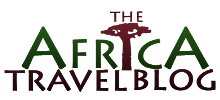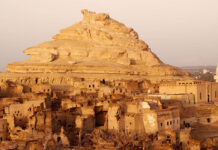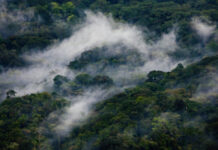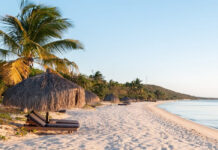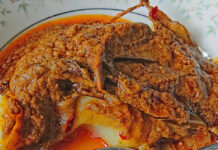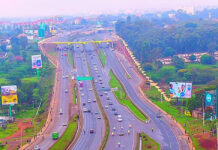From the epic Fish River Canyon in the south through to the rolling red dunes of the Namib Desert, the vast open salt pans of Etosha National Park to the endless horizons and rolling plains of Kaokoland. Namibia is a land of giants; huge skies, enormous sand dunes, planet-like, blood red suns, horizonless roads – there is something entirely awe-inspiring and humbling about travel in this rich yet subtle country.
A landscape that time forgot
NAMIBIA COUNTRY FACTS
Area
825,418km²
Population
2,108,665
Official Languages
English, Afrikaans, German
Major Wildlife Areas/Areas of Interest
Fish River Canyon, Etosha National Park, Kgalagadi Transfrontier Park, Namib Naukluft National Park, Kaokoland, Waterberg Plateau.
Wonderful for
Photographic Safaris, African Honeymoons, Self-Drive Safaris, Riding Safaris, Pure Wildlife Safaris, Barefoot Luxury Safaris.
TripAfrica Suggests
A self drive safari through Southern Namibia, visiting Swakopmund, Sossusvlei, Fish River Canyon and the Kalahari desert, OR, a guided trip into the far North & Kaokoland visiting the stunning Himba tribes.
Accommodation
There are several hotels, lodges and camps in Namibia. There are good quality hotels in Windhoek and Swakompund. Lodges and camps are mainly found in Etosha National Park and other reserves. Advanced booking is advised due to limited availability.
International Travel
Entry into Namibia can be gained through the main airport, Hosea Kutako International Airport, located 38km east of Windhoek. Eros Airport, a medium sized airport in Windhoek and Walvis Bay International airport accommodate smaller aircraft and take regional flights. Air Namibia – the national airline – provides domestic, regional and international flights. South Africa Airways, British Airways, LTU International Airways and Lufthansa Airways also provide regional and international flights.
It is often cheaper to fly to South Africa and then go to Namibia overland or by air. South Africa Airways and Air Namibia operate daily flights between Johannesburg, Cape Town and Windhoek. Air Namibia also provides flights between Windhoek and Harare, Victoria Falls, Lusaka, Maun and Gaborone.
There are roads linking Namibia to South Africa, Botswana, Zambia, Zimbabwe, Angola and bus services operate on these routes. Car hire firms are also available in Windhoek and other major towns. Un-tarred roads such the one linking Botswana to Namibia are being upgraded. The railway network links most towns in Namibia to Windhoek, which then connects to Cape Town and Johannesburg in South Africa.
Local Travel
The national airline and charter flight operators provide domestic flights. This is a quick way of getting between major towns. But it is also an expensive way to travel. Thrifty travelers use road or rail. Bus services between Windhoek and other major towns are available. The Trans-Namib railway operates a good service that connects most major towns. Luxury trains are available for tourists and offer first and second-class options.
Car hire companies are available in major towns for those who wish to drive themselves. Traffic drives on the left and a majority of roads are tarred and thus self-drive is a comfortable experience. An international driving permit is required of foreigners. Make sure to observe speed limits, wear seat belts and adhere to road signs, which are internationally recognized. Taxi and public bus services are available in Windhoek.
Visas
A passport valid for a minimum of 6 months is required. All, except nationals of Angola, Austria, Belgium, Botswana, Canada, Germany, Luxembourg, France, Italy, Ireland, Japan, Liechtenstein, Mozambique, the Netherlands, the Nordic Countries, Russia, Singapore, Malaysia, Australia, New Zealand, Spain, Portugal, South Africa, the United Kingdom, the United States of America, Zambia and Zimbabwe require a visa. The visas are valid for stays of up to 3 months. An extension can be obtained from the Ministry of Home Affairs in Windhoek. Visa requirements however, vary from time to time and you are advised to check on the prevailing status well ahead of travel.
Health
Several private hospitals and clinics in Windhoek and other large towns provide reasonably quality services. However, visitors should take simple precautions to avoid the need to visit these facilities. A day spent in hospital doesn’t do much for your holiday! A yellow fever vaccine certificate is required from travelers coming from yellow fever endemic zones, which are mostly in Africa and South America.
Malaria is prevalent in the northern regions and especially along Kavango and Kunene rivers, provinces of Kunene, Caprivi, Ohangwena, Omaheke, Omusate, Oshana, Oshikoto and Otjozondjupa. The recommended prophylaxis is chloroquine plus proguanil to be taken two weeks prior to your visit. Other preventive measures include; sleeping under a mosquito net, wearing long sleeved tops and trousers, applying mosquito repellants on exposed skin and using insecticide sprays.
Typhoid fever is common throughout the country and especially outside the cities. Vaccination before travel is advisable and care should be exercised in handling food and drink. Tap water in the capital city and other major towns is treated and safe to drink. However one cannot be too careful; bottled water, which is widely available, is safer. Sterilization of water is necessary outside the major towns. Milk is pasteurized and dairy products are safe. Local meat, poultry, seafood, fruit and vegetables are also safe for consumption.
Other vaccinations are recommended to counter; Hepatitis A, Hepatitis B for travelers who may have intimate contact with local residents, especially if visiting for more than six months and rabies, for travelers who may have direct contact with animals. Generally, visitors should also be up to date on tetanus, diptheria, measles and varicella immunizations. Travelers’ diarrhea can occur, thus visitors are advised to carry anti-diarrheal drugs and take proper precautions with food and drink.
Bilharzia is endemic especially in the east of the country. Visitors should avoid swimming or paddling in fresh water; well-chlorinated swimming pools are safer. Appropriate measures should be taken against contracting HIV/AIDS and other STD’s. Those going for safaris are advised to carry anti-bite serums for snakes and scorpions. If you have a significant allergy or chronic medical problem, you should wear a medical alert bracelet. A first aid kit is considered a good investment as an emergency may occur when you are far from any town.
Communications
Telephone, mobile, fax, Internet and postal facilities are widely available in the country. The country code is 264.Mobile phones are based on GSM 900 network and the main network is MTC. There are two main ISP’s- IML and NCS and several Internet cafes are spread out in Walvis Bay and Windhoek. Postal services are quite good with airmail to European countries taking approximately four days to two weeks. The country has five regular major newspapers, four of which are in English; The Namibian and The Windhoek Advertiser which are the daily newspapers, Windhoek Observer which is weekly, The Era printed twice weekly and a daily German newspaper.
Radio stations broadcast on AM 2 and FM 39. The Namibian Broadcasting Corporation (NBC) has nine radio stations and one television station. There are also six privately owned radio stations and one privately owned television station operating from Windhoek. BBC and VOA can be received and their frequencies are available online.
Money
The Namibian Dollar (N$) is the unit of currency. The South African Rand is also acceptable and exchanges at one for one with the Namibian Dollar. There are five commercial banks and several bureaus that can exchange foreign currencies. Travelers’ cheques and major credit cards such as Visa, MasterCard, American Express and Diners Club are widely accepted in hotels and lodges. Visitors are advised to carry travelers’ cheques in US dollars or SA Rand rather than foreign currencies, as the conversion rates for travelers cheques are better.
There is a limit on the import and export of local currency set at fifty thousand Namibian dollars. Foreign currencies are not limited but must declared on arrival. Tipping is only expected in high-class restaurants and hotels but it is not mandatory. It is discouraged in National Parks and reserves.
Peoples & Culture
There are 11 major ethnic groups in Namibia, the largest being the Ovambo who mainly inhabit the north. Other groups include, the Kavango, Herero, Himba, Damara, Nama, Basters, Caprivians among others. The oldest inhabitants of Namibia are the San. Otherwise known as Bushmen, the San people are known for their great story telling, love for music, mimicry and dance.
Each ethnic group has its way of life. The Herero women wear Victorian-style dresses adapted from the wives of Rhenish missionaries. Himba women rub their bodies with a mixture of red ochre and fat. They also wear traditional body ornaments and garments and have hairstyles reflecting their age, sex and social status. The Nama are known for their natural talent in music, poetry and writing style. Their women are highly skilled in sewing. Traditional arts and crafts such as woodcarving, basketry, beadwork, leatherwork and pottery are common practices of the peoples of Namibia. The country also boasts some of the world’s oldest rock paintings and engravings, courtesy of the ancestors of Bushmen.
Restaurants and cafes offer a reasonable choice of local and continental cuisine. Each ethnic group has its own staple food. The Ovambo people enjoy mielie pap, a cornmeal porridge and mahango (millet), which they eat with fish, goat, lamb or beef stew. The Nama prefer the spiky inara melon and Herero mainly eat milk products like curds and butters. Pumpkins, peppers and onions are also widely consumed. Game such as biltong (air-dried meat) and rauchfleisch (smoked meat) are also a specialty.
The official language is English but knowledge of Afrikaans and any other local language will prove useful.
Climate
The climate in Namibia varies from arid and semi-arid to subtropical. The central region is the most arid area. Here, temperatures can rise to 40 degrees centigrade during the day and drop to below freezing at night. There are two rainy seasons; the short rains which fall between October and December and the long rains falling between January and April. The long rains occur during summer. Temperatures are high during the day and cool at night.
Winter occurs from May to September. During this period, large areas are covered with frost. The nights are then cold and the days warm. The Benguela cold current keeps the coast of the Namib Desert cool and free from rain for most of the year. It also leads to the presence of thick fog.
Travel Insurance
Health insurance is essential. Ensure your cover extends to medical expenses abroad including possible evacuation to your country. Carry all your relevant insurance documents and keep them safe. Before travel, clarify whether your insurance plan will pay directly for your health expenses or will reimburse you later. Personal effects and luggage should also be insured as well as cancellation and curtailment insurance taken out.
What to Wear
Light summer clothes are adequate during the day as temperatures can soar especially during summer. Warm clothes should also be carried – the nights get quite chilly even during summer and also for the cold winter mornings. Sunglasses, sunscreen and sun hats will prevent you getting sunburned. If you forget them, don’t panic, they can be bought in all the major towns.
On safari in Namibia, a good pair of light but closed shoes is necessary, as the ground gets quite hot during the day. A lightweight raincoat is useful especially if you travel during the rainy season, that is, January to April. Namibia has been described as a photographers’ paradise, thus a camera and lots of film is necessary packing. Also, a good pair of binoculars is a good investment.
